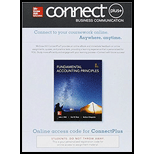
Asset:
An asset means a possession of property tangible or intangible which has some value; such that it can be realized in monetary terms and such asset can be liquidated in short-term or long-term approach so as to derive its value in cash.
Current Assets:
A current asset can be as the asset of any entity that is in the form of cash, cash equivalent or in a form which can be converted into cash within a year. Generally the current are defined to be the ones which can be liquidated within a year but if the company's operating cycle exceeds one year even though the assets are regarded as current assets until they get converted into cash ultimately as the last stage of operating cycle.
Long-term Assets:
Long-term assets are the assets possessed by the company which cannot be liquidated before one year. The minimum maturity period for the said assets is one year. These assets are being recorded in the books at the purchase price and are adjusted by the
a.
To determine: Difference between plant assets and current assets.
Difference between plant assets and inventory.
The difference between plant assets and long-term investments.
Want to see the full answer?
Check out a sample textbook solution
Chapter 10 Solutions
Connect 2-Semester Access Card for Fundamental Accounting Principles
- Please provide the accurate answer to this general accounting problem using valid techniques.arrow_forwardCan you solve this general accounting problem using accurate calculation methods?arrow_forwardEdvard Technologies sells premium headphones. The unit selling price is $85, the unit variable costs are $37.25, fixed costs are $175,000, and current sales are 12,000 units. How much will operating income change if sales increase by 4,500 units?arrow_forward
- Novak Inc. sells one product, its waterproof camping tent. It began operations in the current year and had an ending inventory of 6,200 units. The company sold 18,500 units throughout the year. Fixed manufacturing overhead is $9 per unit, and total manufacturing cost per unit is $31.75 (including fixed manufacturing overhead costs). What is the difference in net income between absorption and variable costing?arrow_forwardProvide Answerarrow_forwardCan you provide the accurate answer to this financial accounting question using correct methods?arrow_forward
- I am looking for a reliable way to solve this financial accounting problem using accurate principles.arrow_forwardWestfield Retail Store had a balance in the Accounts Receivable account of $380,000 at the beginning of the year and a balance of $420,000 at the end of the year. Net credit sales during the year amounted to $2,800,000. The average collection period of the receivables in terms of days was___. (Round your answer to nearest number)arrow_forwardSolve this question and accounting questionarrow_forward
- The cost of goods sold is found on which financial statement? (1) Statement of Cash Flows (2) Balance Sheet (3) Statement of Retained Earnings (4) Income Statementarrow_forwardPlease provide the correct answer to this general accounting problem using accurate calculations.arrow_forwardCan you explain the correct methodology to solve this general accounting problem?arrow_forward

 AccountingAccountingISBN:9781337272094Author:WARREN, Carl S., Reeve, James M., Duchac, Jonathan E.Publisher:Cengage Learning,
AccountingAccountingISBN:9781337272094Author:WARREN, Carl S., Reeve, James M., Duchac, Jonathan E.Publisher:Cengage Learning, Accounting Information SystemsAccountingISBN:9781337619202Author:Hall, James A.Publisher:Cengage Learning,
Accounting Information SystemsAccountingISBN:9781337619202Author:Hall, James A.Publisher:Cengage Learning, Horngren's Cost Accounting: A Managerial Emphasis...AccountingISBN:9780134475585Author:Srikant M. Datar, Madhav V. RajanPublisher:PEARSON
Horngren's Cost Accounting: A Managerial Emphasis...AccountingISBN:9780134475585Author:Srikant M. Datar, Madhav V. RajanPublisher:PEARSON Intermediate AccountingAccountingISBN:9781259722660Author:J. David Spiceland, Mark W. Nelson, Wayne M ThomasPublisher:McGraw-Hill Education
Intermediate AccountingAccountingISBN:9781259722660Author:J. David Spiceland, Mark W. Nelson, Wayne M ThomasPublisher:McGraw-Hill Education Financial and Managerial AccountingAccountingISBN:9781259726705Author:John J Wild, Ken W. Shaw, Barbara Chiappetta Fundamental Accounting PrinciplesPublisher:McGraw-Hill Education
Financial and Managerial AccountingAccountingISBN:9781259726705Author:John J Wild, Ken W. Shaw, Barbara Chiappetta Fundamental Accounting PrinciplesPublisher:McGraw-Hill Education





